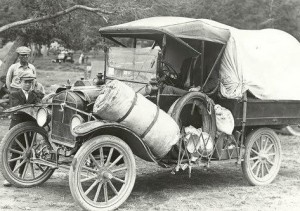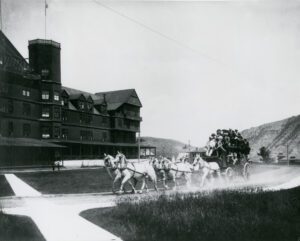Uncategorized
A century of automobiles in Yellowstone
Published
9 years agoon
Posted By
Outlaw Partners
End of the stagecoach era and start of the great American road trip
By Mark Wilcox EBS Contributor
It may have been a backfire, but it sounded more like the end of the world.
At least that’s what one historian likened it to when the first automobile chugged its way into Yellowstone National Park, beginning to trace over the lines made by stagecoaches throughout the park.
“The best of all possible worlds came to a shaking, rattling, backfiring end at exactly 7 p.m. on the evening of July 31, 1915,” wrote historian Richard Bartlett in the summer 1970 issue of Montana the Magazine of Western History.
The erasure of the coach lines didn’t come until a year later, when commercial transportation switched from dust-encrusted stagecoaches to motorized vehicles, at the end of the 1916 season. This year marks the centennial of that world-changing transition in the first national park, for better or worse.
Historians diverge in their acceptance of the change, but all agree that it was a major transition making access to the park more affordable and altered the nature of who came to Yellowstone.
“The automobile democratized the park—made it so anyone could get here,” said Leslie Quinn, an interpretive specialist and historian for Xanterra Parks & Resorts, the current hotelier in Yellowstone.
Author and avocational historian Robert Goss said the change untied people from strict travel schedules and allowed them to avoid high prices from monopolistic hotels and railroads.
“Common folks could eventually enjoy the wonders of nature along with the upper crust,” Goss said.
Coach class
Today, “taking coach” is synonymous with roughing it, but in the early days of Yellowstone it was the only way to travel. It was very expensive and coach-class travelers had to be pretty wealthy.
From relatively nearby Salt Lake City, a round-trip rate to Yellowstone in 1899 was $58, including rail and stage travel on the Monida & Yellowstone Stage Line. For comparison, hotel stays in the park were $4 per night.
The Bureau of Labor Statistics’ inflation calculator only converts dollars as far back as 1913, but at that time $58 equated to nearly $1,400 in today’s dollars. At that price, flying coach from Salt Lake City today could take a traveler to London and back.
Stagecoaches, while seen in a romantic light now, were anything but.
“The stagecoach experience was a slow, really dirty, kind of arduous trip,” said Marin Aurand, a historian who manages the Yellowstone Historic Center Museum in West Yellowstone. “It was a hard way to travel through Yellowstone.”
Dust pulverized by steel-rimmed wagon wheels and iron-shod horse hooves clung to the air, a miasma that coated everything and never seemed to settle. It was the kind of dust that coated lungs and made people long for open water and fresh air. The omnipresent dust was by far the chief complaint of wagon tour riders, most of whom came from high socioeconomic backgrounds.
Author Rudyard Kipling visited the park in 1889 and called the dust “as dense as fog,” despite spacing of at least 500 yards between each stagecoach. The few who lived close enough to Yellowstone to take their own buggies into the park were derisively referred to as “sage brushers.” This name came from their tendency to camp in the sagebrush rather than frequenting establishments like Lake Hotel, which is celebrating its 125th anniversary this year.
While the rides themselves may not have been glamorous, the company was colorful. Riders often mentioned their drivers stashing whiskey under the driver’s seat. That was before open-container laws were in effect.
In the coach, camaraderie developed between the riders and the coachmen were the original interpreters of the park. They shared stories that could only be gotten from a tour – even if some of them were patently false. Kipling wrote of one driver who went by “Geyser Bob” Edgar. The man would drop a handkerchief in one geyser before “retrieving” it from another miles down the trail, creating the illusion of an underground network of thermal features.
Robert Goss has adopted the name “Geyser Bob” for his website documenting Yellowstone’s history, though he hasn’t carried forward the handkerchief trick.
Sharing the road
Getting cars on the road in Yellowstone represented no small challenge, especially since most of the roads weren’t paved until the 1930s. Opponents argued that cars on the road would spook horses and create logistical problems and they weren’t entirely wrong.
Goss said no deaths resulted from cars and stagecoaches sharing the dirt roads, but the Livingston Enterprise told of one incident in July 1916 shortly before the commercial swap to automobiles.
A commercial four-horse stagecoach from the Wylie Permanent Camping Co. left Mammoth headed toward the train depot in Gardiner. A mile or so into the short, but steep descent it came upon a stalled automobile.
“The horses panicked and cut loose down the hill, almost going over the edge into the canyon,” Goss said. “The coach flipped on its side and all the passengers were thrown from the coach, crushing many of them between the coach and a rock outcropping. All were injured to some extent and three of the people suffered serious fractures.”
Aurand of the Yellowstone Historic Center said that regulations had progressed slowly before cars came into the park, and Yellowstone ended up being one of the last parks to allow automobiles. When cars came in it marked the “end of the world,” but the start of a new era.
“Essentially this is the start of the great American West road trip,” Aurand said. “It feels more American almost to be able to go by car.”
Rattling into history
The end of the 1916 season marked the end of commercial stagecoach access to Yellowstone. While sage brushers could still come, and did so for decades longer, concessionaires flipped the historic switch. The results mostly speak for themselves.
“There is a sense that the relative peacefulness and tranquility of stage travel mostly disappeared when the noisy and smoke-belching autos arrived on the scene, signaling the end of a sometimes romanticized travel era,” Goss said. “The increasing reliance on private automobiles over commercial transportation has led to significantly over-crowded roads, huge swaths of land paved over for parking lots and probably a greater disturbance to the wildlife.”
But that is not entirely a bad thing, as millions of people now enjoy a national treasure each year compared to the 20,000 visitors the park had in 1914, the last year before cars were allowed. The following year, visitation jumped to more than 52,000.
“It’s always a toss-up between allowing access and preserving the landscape,” Aurand said. “It’s a really tough balance.”
She predicted a time when the finite space in the park will be overwhelmed and some sort of limit will be placed on the amount of people coming through the gates. But for now, “those infernal internal combustion machines,” as the historian Bartlett called them, have given relatively free access to a natural wonder.
Mark Wilcox is a storyteller who grew up in Jackson, Wyo. and the founder of Sheen Startups (sheenonline.com). He avoids Yellowstone during peak season because of “those infernal machines,” preferring trips in May and October.
The Outlaw Partners is a creative marketing, media and events company based in Big Sky, Montana.


Upcoming Events
november, 2024
Event Type :
All
All
Arts
Education
Music
Other
Sports
Event Details
Spanish Classes with World Language InitiativeThese unique, no cost Spanish classes are made possible by the contribution of Yellowstone Club
more
Event Details
Spanish Classes with World Language InitiativeThese unique, no cost Spanish classes are made possible by the contribution of Yellowstone Club Community Foundation (YCCF) and Moonlight Community Foundation (MCF). This class will focus on building a lifelong affinity for world languages and cultures through dynamic and immersive Communicative Language teaching models.
Beginner Class – Mondays and Wednesdays from 5:30-6:30 pm
Intermediate Class – Mondays and Wednesdays from 6:45- 7:45 pm
- Classes begin Oct.7, 2024 and run for 6 weeks
- Class size is limited to 12 students
- Classes are held in Big Sky at the Big Sky Medical Center in the Community Room
For more information or to register follow the link below or at info@wlimt.org.
Time
October 14 (Monday) 5:30 pm - November 20 (Wednesday) 7:45 pm
Location
Big Sky Medical Center - Community Room (2nd Floor)
Big Sky Medical Center - Community Room (2nd Floor)
Event Details
Spanish Classes with World Language InitiativeThese unique, no cost Spanish classes are made possible by the contribution of Yellowstone Club
more
Event Details
Spanish Classes with World Language InitiativeThese unique, no cost Spanish classes are made possible by the contribution of Yellowstone Club Community Foundation (YCCF) and Moonlight Community Foundation (MCF). This class will focus on building a lifelong affinity for world languages and cultures through dynamic and immersive Communicative Language teaching models.
Beginner Class – Mondays and Wednesdays from 5:30-6:30 pm
Intermediate Class – Mondays and Wednesdays from 6:45- 7:45 pm
- Classes begin Oct.7, 2024 and run for 6 weeks
- Class size is limited to 12 students
- Classes are held in Big Sky at the Big Sky Medical Center in the Community Room
For more information or to register follow the link below or at info@wlimt.org.
Time
October 21 (Monday) 5:30 pm - November 27 (Wednesday) 7:45 pm
Location
Big Sky Medical Center - Community Room (2nd Floor)
Big Sky Medical Center - Community Room (2nd Floor)
Event Details
Spanish Classes with World Language InitiativeThese unique, no cost Spanish classes are made possible by the contribution of Yellowstone Club
more
Event Details
Spanish Classes with World Language InitiativeThese unique, no cost Spanish classes are made possible by the contribution of Yellowstone Club Community Foundation (YCCF) and Moonlight Community Foundation (MCF). This class will focus on building a lifelong affinity for world languages and cultures through dynamic and immersive Communicative Language teaching models.
Beginner Class – Mondays and Wednesdays from 5:30-6:30 pm
Intermediate Class – Mondays and Wednesdays from 6:45- 7:45 pm
- Classes begin Oct.7, 2024 and run for 6 weeks
- Class size is limited to 12 students
- Classes are held in Big Sky at the Big Sky Medical Center in the Community Room
For more information or to register follow the link below or at info@wlimt.org.
Time
October 28 (Monday) 5:30 pm - December 4 (Wednesday) 7:45 pm
Location
Big Sky Medical Center - Community Room (2nd Floor)
Big Sky Medical Center - Community Room (2nd Floor)











